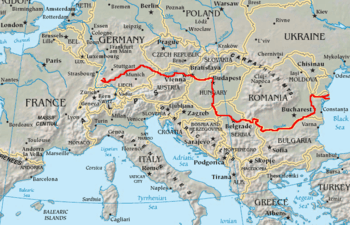Shoes on the Danube Bank

The Shoes on the Danube Bank is a memorial in Budapest, Hungary. Conceived by film director Can Togay, he created it on the east bank of the Danube River with sculptor Gyula Pauer to honor the people (mainly Budapest Jews) who were killed by fascist Arrow Cross militiamen in Budapest during World War II. They were ordered to take off their shoes, and were shot at the edge of the water so that their bodies fell into the river and were carried away. It represents their shoes left behind on the bank.
The Memorial
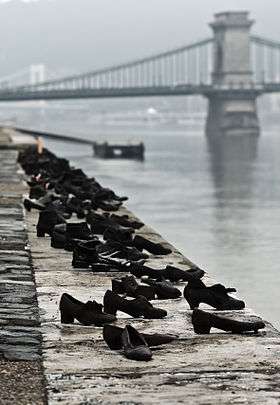
The monument is located on the Pest side of the Danube Promenade in line with where Zoltan Street would meet the Danube if it continued that far, about 300 metres (980 ft) south of the Hungarian Parliament and near the Hungarian Academy of Sciences; between Roosevelt Square and Kossuth square.[1]
"The composition titled 'Shoes on the Danube Bank' gives remembrance to the 3,500 people, 800 of them Jews, who were shot into the Danube during the time of the Arrow Cross terror.[2] The sculptor created sixty pairs of period-appropriate shoes out of iron. The shoes are attached to the stone embankment, and behind them lies a 40 meter long, 70 cm high stone bench. At three points are cast iron signs, with the following text in Hungarian, English, and Hebrew: "To the memory of the victims shot into the Danube by Arrow Cross militiamen in 1944–45. Erected 16 April 2005."[3]
January 1945
During World War II, Valdemar Langlet, head of Svedan Red Cross in Budapest, with his wife Nina, and later the diplomat Raoul Wallenberg and 250 coworkers were working around the clock to save the Jewish population from being sent to Nazi concentration camps; this figure later rose to approximately 400. Lars and Edith Ernster, Jacob Steiner, and many others were housed at the Swedish Embassy in Budapest on Üllői Street 2-4 and 32 other buildings throughout the city which Wallenberg had rented and declared as extraterritorially Swedish to try to safeguard the residents.
Italian Giorgio Perlasca did the same, sheltering Jews in the Spanish Embassy.
On the night of 8 January 1945, an Arrow Cross execution brigade forced all the inhabitants of the building on Vadasz Street to the banks of the Danube. At midnight, Karoly Szabo and 20 policemen with drawn bayonets broke into the Arrow Cross house and rescued everyone (see also front page of 1947 newspaper below).[4] Among those saved were Lars Ernster, who fled to Sweden and became a member of the board of the Nobel Foundation from 1977 to 1988, and Jacob Steiner, who fled to Israel and became a professor at the Hebrew University of Jerusalem. Steiner's father had been shot dead by Arrow Cross militiamen 25 December 1944, and fell into the Danube. His father had been an officer in World War I and spent four years as a prisoner of war in Russia.[5]
Dr. Erwin K. Koranyi, a psychiatrist in Ottawa, wrote about the night of 8 January 1945 in his Dreams and Tears: Chronicle of a Life (2006), "in our group, I saw Lajos Stoeckler" and "The police holding their guns at the Arrowcross cutthroats. One of the high-ranking police officers was Pal Szalai, with whom Raoul Wallenberg used to deal. Another police officer in his leather coat was Karoly Szabo."[6]
Pal Szalai was honored as Righteous among the Nations 7 April 2009 for helping save these Hungarian Jews.[7][8]
Karoly Szabo was honored as Righteous among the Nations 12 November 2012.[9]
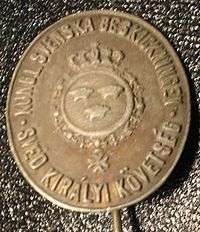 Swedish Legation Budapest 1944
Swedish Legation Budapest 1944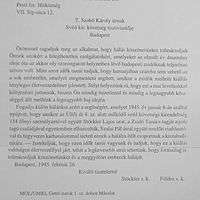 Document [10] in the National Archives of Hungary 1945. Thank you letter from Lajos Stöckler, President of the Jewish Community of Budapest, to Karoly Szabo for rescuing 154 persons and his family (8 persons).
Document [10] in the National Archives of Hungary 1945. Thank you letter from Lajos Stöckler, President of the Jewish Community of Budapest, to Karoly Szabo for rescuing 154 persons and his family (8 persons).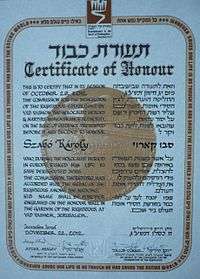
2014 Defacement of the Memorial
In September 2014, the Israeli newspaper Ha'aretz reported that several bronze shoes were stolen from the Danube Holocaust memorial, citing the Budapest Beacon. Ha'aretz noted that "it was not immediately clear whether the theft in Budapest, not far from the Hungarian parliament building, was an anti-Semitic act or a meaningless prank. Police said they were not investigating the case because no crime has been reported, said Hungarian newspaper Nepszabadsag."[11]
See also
References
- ↑ Népszabadság Online, April 15, 2005.
- ↑ https://books.google.co.uk/books?id=sd7eAAAAQBAJ&pg=PA78&dq=shoes+on+the+river+danube&hl=en&sa=X&redir_esc=y#v=onepage&q=shoes%20on%20the%20river%20danube&f=false
- ↑ MTI, Saturday, April 16, 2005.
- ↑ http://www.spacetime-sensor.de/wallenberg.htm
- ↑ Letter from Jacob Steiner 12 February 2007 to Tamas Szabo
- ↑ Koranyi, Erwin K. (2006). Dreams and Tears: Chronicle of a Life. General Store Publishing House. pp. 89–90. ISBN 978-1-897113-47-9. Retrieved 2014-12-04.
- ↑ "Israel honors Hungarians who saved Jews". NBC News. Associated Press. 7 April 2009. Retrieved 2014-12-04.
- ↑ http://www.bm.hu/web/portal.nsf/archiv_hir/CFFF58DD8F82C2E1C125758C0060313B?OpenDocument MTI Magyar Távirati Iroda
- ↑ https://picasaweb.google.com/113991532842050650466/Wallenberg98Eves#5812530032331649794
- ↑ Szabo, Tamas. Who was the man in the leather coat?.
- ↑ http://www.haaretz.com/jewish/news/1.615154
Bibliography
- Gábor, Forgács (2006). Emlék és Valóság: mindennapjaim Raoul Wallenberggel [Recollections and Facts: My Days with Raoul Wallenberg] (in Hungarian). Budapest: Kolor Optika. ISBN 9789630600309.
- Koranyi, Erwin K. (2006). Dreams and Tears: Chronicle of a Life. General Store Publishing House. pp. 89–90. ISBN 978-1-897113-47-9.
- Szekeres, József (1997). A pesti gettok 1945 januari megmentese: "a magyar Schindler", Szalai Pal visszaemlekezesei es mas dokumentumok [Saving the Ghettos of Budapest in January 1945: "Hungarian Schindler," Pal Szalai's recollections]. Varostorteneti tanulmanyok (in Hungarian). Budapest: Budapest Fovaros Leveltara [Budapest Archives]. ISBN 978-963-7323-14-0.
External links
- Rescue Story on the Danube Bank in Yad Vashem Database of Righteous
- Gyula Pauer site including a map, photographs and a film
- Jewish Budapest site
- Shoes on the Danube Promenade at rumboanada
- Edith Ernster remembers
- Document about January 8, 1945. in Budapest Archives (Hungarian)
- Other documents about January 8, 1945. (English)
- Photographs of the shoes at Szoborlap.hu
- Jewish.hu - The shoes on the river
Coordinates: 47°30′14.05″N 19°02′41.22″E / 47.5039028°N 19.0447833°E

